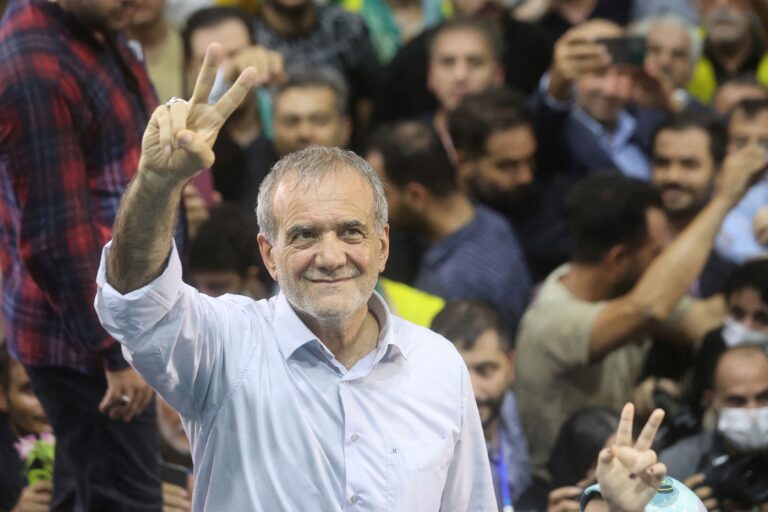FILE PHOTO: Presidential candidate Massoud Pezeshkian gives a victory sign during an election campaign in Tehran, Iran, June 23, 2024.
Majid Asgaripour | via Reuters
In Iran, Massoud Pezeshkian was elected president in an unexpected victory for reformists at a time of deep social discontent, economic hardship and regional wars.
Pezeshkian won 16.3 million votes, a turnout of 49.8 percent, according to reports citing local authorities. His hard-right rival, Saeed Djalili, a former nuclear negotiator, finished with 13.5 million votes.
Pezeshkian, 69, beat several staunchly conservative candidates despite many analysts describing him as a “reformist in name only” and a “second-tier candidate” among lesser-known candidates.
The most moderate of the candidates, he served as health minister under Iran’s last reformist president, Mohammed Khatami, from 1997 to 2005 and was supported by Khatami and other reformist politicians.
Pezeshkian has also been a member of parliament since 2008, a member of the Islamic Consultative Assembly and deputy speaker of parliament. She wants to ease Iran’s strict hijab laws and other social restrictions, and improve ties with the West, even considering resuming nuclear negotiations with world powers.
Cars pass a billboard displaying the faces of six presidential candidates – Mohammad Bagher Ghalibaf, Amirhossein Ghazizadeh Hashemi Alireza Zakhani, Saeed Djalili, Mostafa Pourmohammadi and Massoud Pezeshkianin – in the Iranian capital Tehran on June 29, 2024. Massoud Pezeshkian, Iran’s only reformist candidate, and ultra-conservative Saeed Djalili received the most votes in Iran’s presidential election and will advance to a runoff election, according to Iran’s Interior Ministry.
Atta Kenare | AFP | Getty Images
Iran’s new president will have to contend with whoever occupies the White House in November. This raises risks for both Tehran and Washington, and the entire Middle East, as Iran moves ever closer to the ability to build a nuclear bomb and continues to back proxy groups fighting Israel.
On issues of foreign policy and war, the Iranian president wields some influence and is the emissary to the nation, but power and major decision-making in Iran ultimately rests with Supreme Leader Ayatollah Khamenei and unelected institutions such as the Revolutionary Guard.
“The elections may lead to changes in Iran’s domestic and foreign policy priorities, direction and tactics, but a fundamental change in the status quo is unlikely,” Sina Toussi, a senior adjunct fellow at the Center for International Policy, told CNBC.
“The core principles guiding Iran’s strategic decisions, particularly with regard to the United States and Israel, are firmly rooted in the broader framework set by the Supreme Leader and influential institutions like the Revolutionary Guards,” he said.
A Pezeshkian victory “could pave the way for a re-establishment of diplomatic relations and some progressive domestic policies,” Toosi said. “But even if a reformist president is elected, the extent of change will be limited by the overarching power structures and strategic imperatives that define the Iranian political landscape. Thus, any real change is likely to be gradual and incremental, rather than transformational.”
Iran’s elections were held following the unexpected death of former President Ebrahim Raisi in a helicopter crash in May.
Iran’s elections are not considered free or fair because the country’s ultra-conservative Guardian Council has the final say on who can run in the election. Voting was open to Iran’s roughly 61 million citizens, but many have vowed to boycott, pointing out that voters have no real choice.
The council approved only six of the 80 candidates who registered for the presidential election, disqualifying all women. Of the six approved candidates, five were hardline conservatives and three were under sanctions from Western governments.

